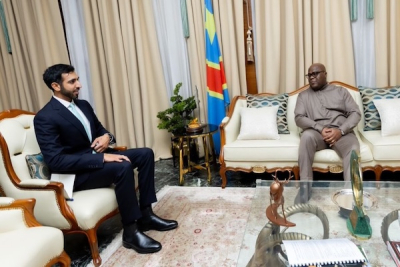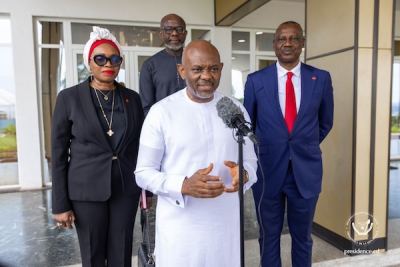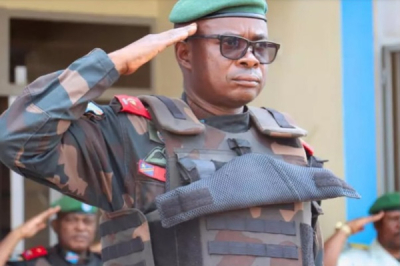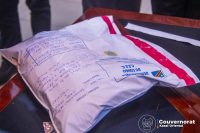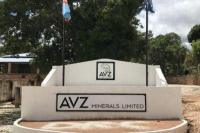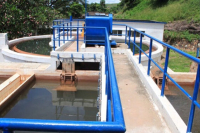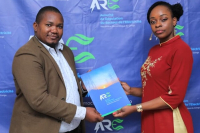
News (571)
The Democratic Republic of Congo (DRC) has received its first shipment of Chinese-made construction equipment under a major road partnership with South African group Guma.
Infrastructure and Public Works Minister John Banza Lunda oversaw the arrival of 200 units of civil engineering machinery from China on November 14, according to an official statement. The shipment included dump trucks, bulldozers and various utility vehicles.
The equipment is the first batch of a 5,600-unit order tied to a partnership announced by the Prime Minister’s Office in February 2024 at the Mining Indaba forum in South Africa. At the time, the government said it had reached an agreement with the Development Bank of Southern Africa (DBSA) and Guma Africa to support an extensive road development program.
The contract covers a planned network of 180,000 kilometers of roads, valued at 450 million dollars. The financing is intended to support equipment purchases, road rehabilitation and maintenance by the Ministry of Infrastructure, and training for operators and technicians within the Roadways and Drainage Authority (OVD) and the Road Office (OR).
Financing and Delays
Although the project was initially expected to roll out over three years, the Ministry of Infrastructure said the contract was not formally signed until August 29, 2025.
The financing structure remains unclear. The Ministry only specified that the project is being “financed without a sovereign guarantee.” The arrangement appears to follow a leasing model in which DBSA acts as the financier, Guma supplies the machinery and the Congolese state leases the equipment. The government would use the machines for road works and repay the cost through lease fees, with ownership passing to the state once the full amount is covered.
Technical details for the planned roads have not yet been released, but the announced budget indicates that the work will mainly involve dirt roads.
In February 2024, the Prime Minister’s Office described the program as a major boost to the Local Development Program for 145 Territories (PDL-145T). The second phase of the PDL-145T, launched in the third quarter of 2022, covers the rehabilitation of more than 38,000 kilometers of rural access roads and related infrastructure, at a cost of 1.25 billion dollars. How the two road programs will be coordinated is still unclear.
During his visit to the DRC on August 29, Guma Group CEO Robert Gumede said the project “will transform the lives of Congolese people by reducing transport costs and stimulating agriculture and industry.” He added that the main objective is to improve links between urban and rural areas to support mobility and strengthen regional integration.
Pierre Mukoko & Timothée Manoke
Entreprise Générale du Cobalt (EGC), a subsidiary of state-owned Gécamines, presented 1,000 tons of artisanally mined cobalt on November 13, 2025, describing the material as “structured, ethical and traceable.”
The event, titled “1,000 Tons of Future,” aimed to demonstrate to markets and investors that artisanal cobalt can meet international expectations on transparency, profitability, and ESG compliance.
EGC General Director Eric Kalala said the company hopes to attract investment that will help build a competitive, nationally controlled artisanal mining industry.
An Informal Sector with Heavy Reliance
The Democratic Republic of Congo (DRC) holds about 72 percent of global cobalt reserves and supplies more than 74 percent of world production. EGC estimates that a significant share of this output comes from artisanal mining, a sector that employs between 1.5 million and 2 million people and supports more than 10 million others.
Despite its economic importance, the sector operates largely outside formal structures. It is marked by non-transparent buying practices, low prices, unsafe working conditions and the dominance of unregulated intermediaries. These problems prompted the U.S. Labor Department to add Congolese cobalt to its 2024 list of goods suspected of being produced with child labor.
Created in 2019, EGC is mandated to organize, purchase and market artisanal cobalt while improving traceability, compliance and fair pay. The company also aims to increase local value addition through small-scale processing, strengthen cooperatives and offer miners more predictable incomes.
Push for Transparency
To carry out its mission and secure financing, EGC says it has developed a model designed to bring the artisanal segment up to international standards.
“The company is deploying controlled mining zones with weighing stations, direct-payment systems and digital tracking tools to ensure every ton is traceable from the mining site to processing,” EGC said.
However, EGC did not disclose where the 1,000 tons presented in Kolwezi were mined. The lack of clarity is significant for industrial buyers, who frequently accuse artisanal miners of entering their concessions illegally. Such incursions regularly spark disputes and, according to the Federation of Congolese Enterprises, have caused nearly 3 billion dollars in losses for one mining company.
Government Response
In response, President Félix-Antoine Tshisekedi announced several measures during the 47th Council of Ministers in Kolwezi on June 13, 2025. These include quickly designating legal artisanal mining zones and opening discussions with mining companies, including Gécamines, to release specific land parcels.
Gécamines had already made five pilot sites available to EGC around Kolwezi in February 2024. The sites were intended to support a roadmap to gradually formalize the artisanal cobalt sector. An exploration program began soon after, and EGC announced in September 2024 that targeted drilling would start on one of the locations. Results have not yet been published.
Pierre Mukoko & Ronsard Luabeya
The Democratic Republic of Congo’s Industrial Promotion Fund (FPI) is seeking partnerships with three major Singaporean economic bodies: the Singapore Cooperation Enterprise (SCE), the Economic Development Board (EDB) and Enterprise Singapore (ESG).
FPI Director-General Hervé Claude Ntumba Batukonke met officials from the three institutions during an economic mission to Singapore from November 1 to 8, 2025. The visit was held at the invitation of Embed Financial Group Holdings (EFGH Singapore).
According to an FPI statement, talks with SCE—which develops government-to-government partnerships and capacity-building initiatives—focused on industrial policy, digitalization and skills development. SCE expressed support for reforms underway in the DRC in these areas.
Discussions with the EDB, the agency responsible for attracting investment in sectors such as technology, finance, industry and biotechnology, highlighted opportunities to draw investors into Congolese industrial projects.
FPI also met with Enterprise Singapore, which sees the DRC as a potential partner for future industrial projects. ESG supports the international expansion of Singaporean companies and says it has nearly $20 billion in committed investments across African projects. The agency provides financing, technical support and training for small and medium-sized enterprises.
According to Ntumba, the meetings highlighted the DRC’s economic strengths and presented new investment opportunities in industry. Following the mission, FPI and the Singaporean agencies agreed on several next steps. These include formalizing a bilateral cooperation framework, preparing FPI’s participation in the 2027 International Conference with a list of priority projects, and establishing a mechanism to monitor the progress of investment commitments.
Ronsard Luabeya
Abu Dhabi Ports, the Emirati state-owned company, is considering investments in the Democratic Republic of Congo’s (DRC) Matadi and Boma ports. The potential projects were discussed during a meeting between President Félix-Antoine Tshisekedi and Emirati Minister of State for Foreign Affairs Sheikh Shakhboot Nahyan Al Nahyan on November 16, 2025.
No details were disclosed on the scale of Abu Dhabi Ports’ plans. According to the Congolese Presidency, the port initiatives fall within a wider infrastructure program that includes the Lobito Corridor, two dry ports, and road links from Kolwezi to Dilolo, as well as connections between the DRC, Angola, and Zambia.
The initiative aims to strengthen economic cooperation between the two countries. The Presidency said talks also covered the mining sector, the exchange of financial intelligence to combat money laundering and terrorist financing, and cooperation between the two central banks. Both sides discussed completing a long-delayed free trade agreement and organizing an economic forum to attract investment.
Between 2021 and 2023, Congolese exports to the UAE averaged $1.059 billion per year, compared with $1.89 billion in imports, leaving an average annual trade deficit of $650 million. Exports are dominated by mining products such as refined copper, gold, and diamonds.
Trade could increase following the acquisition by Emirati conglomerate IRH/IHC of a 56% stake in Alphamin Resources, the owner of the Bisie tin mine, which strengthens the UAE’s presence in the DRC’s mining sector.
Two other Emirati companies, Lone Star Ltd and Business Gate, have also expressed interest in energy projects in Tshopo Province, particularly in renewable energy.
Boaz Kabeya
- UBA will appoint a Congolese national as CEO of UBA DRC and add nine Congolese board members.
- The bank plans to expand from 3 to 21 branches by 2028 and target USD 1.8 billion in deposits.
- UBA DRC grew net profit 388% in 2024, reaching 21 billion naira.
United Bank for Africa Chairman Tony Elumelu announced a sweeping localisation plan for UBA Democratic Republic of Congo after meeting President Félix Tshisekedi on November 16, 2025. Elumelu outlined the changes during a visit to Kinshasa, according to a summary posted by the presidency on X.
The presidency stated that UBA DRC will appoint a Congolese national to lead the subsidiary. It added that nine Congolese members will join the board as part of a strategy to progressively “Congolize” the management structure. The subsidiary is currently led by Nigerian national Sampson Aneke, who is supported by Deputy Managing Director Gisèle Bondo, appointed in February 2024.
Elumelu said the bank plans to extend its branch network into several provinces across the country. “We believe in the potential of the DRC, especially its youth. The opening of new branches will help create jobs,” he said.
UBA has operated in the DRC since 2011. The bank currently maintains branches in Kinshasa, Lubumbashi and Matadi. The group detailed in its 2024 Pillar Report that its 2024–2028 strategic plan targets a major expansion—growing from three to 21 branches by 2028 and increasing its ATM network. The subsidiary also aims to reach a deposit base of $1.8 billion over the same period.
UBA DRC significantly increased its contribution to group results in 2024. The bank reported a net profit of 21 billion naira, compared with 4.3 billion naira in 2023. This performance marks a 388% year-on-year increase, according to documents reviewed by Bankable. The results mainly reflect growth in operating income, which rose from 4.3 billion to 22.8 billion naira.
Elumelu said the group also plans to expand its involvement in infrastructure financing in the DRC. Through the Tony Elumelu Foundation, he reaffirmed the bank’s commitment to supporting local entrepreneurship. Since the launch of the foundation’s programme, 350 young Congolese entrepreneurs have received financial support.
This article was initially published in French by Ronsard Luabeya
Adapted in English by Ange Jason Quenum
North Kivu province in eastern Democratic Republic of Congo has launched a new campaign to collect illegally held weapons and ammunition. The move comes as the region, which remains under a state of siege, faces persistent insecurity.
The provincial government said in a statement issued on November 12 that military governor Major-General Evariste Kakule Somo signed an order on October 29 authorizing the operation.
The order offers cash rewards to anyone who voluntarily hands in weapons: 100 dollars for an AK-47 or similar rifle, 200 dollars for a support weapon, and 1 dollar per round of ammunition. It also guarantees anonymity and immunity from prosecution for participants.
A commission that includes the Disarmament, Demobilization, Community Recovery and Stabilization Program (PDDRCS) has been set up to oversee the campaign. The provincial government said the effort is funded by the central government with possible support from technical and financial partners and individual donors.
The initiative follows a rise in violent crime in Beni and Butembo, where banks, homes and businesses have been repeatedly targeted by armed groups. Civil society groups have urged authorities to tighten controls on the movement of weapons in the province.
Similar programs have been carried out in the past. Between 2008 and 2011, the NGO Peace and Reconciliation (PAREC) ran a weapons-collection campaign across several provinces after waves of violence. In North Kivu, PAREC sought to collect 30,000 weapons and had recovered about 9,347 by October 2010, according to local media. By July 2011, it had handed over more than 7,545 weapons and 54 tons of ammunition to military experts. In Kinshasa, more than 11,000 illegally held weapons were recovered in 2009, Le Figaro reported.
Timothée Manoke
Security officers at Bipemba Airport in Mbujimayi, Democratic Republic of Congo, seized 13 kilograms of diamonds on November 11, 2025, after discovering the cargo had not been declared for transport to Kinshasa.
Provincial anti-fraud services and the Provincial Mining Division said the stones were not listed on any official paperwork and had not been reported to the authorities, in breach of national traceability rules.
The diamonds were brought to interim provincial governor Daniel Kazadi Cilumbayi, who called a security meeting with all agencies active at the airport, including the police, the National Intelligence Agency, the Mining Division, and anti-fraud units. The meeting focused on determining how the attempted smuggling occurred and improving coordination among security services.
Kazadi praised the officers involved and said the provincial government remained committed to tackling mineral trafficking. “There will be no tolerance for such practices. The law must be strictly applied,” he said, adding that smuggling undermines supply-chain transparency and deprives the province of revenue.
The governor instructed security and mining authorities to strengthen checks at all exit points in the province and urged closer cooperation among the institutions responsible for anti-fraud work.
The seized diamonds were transferred to the Centre for Expertise, Evaluation and Certification (CEEC) and the Provincial Mining Division for technical analysis and valuation, the governor’s office said. With no claimant for the cargo, an investigation has been opened to identify those responsible.
Ronsard Luabeya
The Australian Securities and Investments Commission (ASIC) said on Tuesday, Nov. 11, that it had initiated Federal Court proceedings against AVZ Minerals, the mining company that claimed mining rights over the Manono lithium deposit in the Democratic Republic of Congo (DRC).
The regulator alleges that the company and two of its directors failed to meet their disclosure obligations to investors concerning the legal dispute surrounding the project. AVZ was listed on the Australian Securities Exchange (ASX) until trading was suspended in May 2022. It was delisted in May 2024.
Through its subsidiary Dathcom Mining, AVZ held a 75 percent stake in a licence covering part of the Manono site, which is widely regarded as the DRC’s largest lithium deposit, but it never secured the mining rights. In October 2023, joint-venture partner Cominière, a state-owned company, announced that it had signed an agreement to operate part of the deposit with China’s Zijin Mining Group. AVZ is contesting these developments and has launched several international legal proceedings to defend its claims.
ASIC alleges that the company failed to disclose information about the dispute for nearly a year. Managing Director Nigel Ferguson and Technical Director Graeme Johnston are also accused of breaching their duties as directors by allowing the publication of “false or misleading” announcements to the ASX.
“It was all but impossible for retail investors to travel to an overseas location in central Africa where the company’s operations were being conducted. In those circumstances, investors rely on the company to provide accurate and timely information. We allege Mr Ferguson and Mr Johnston failed to inform investors of the ongoing issues in this case for nearly 12 months,” ASIC Deputy Chair Sarah Court said.
AVZ and its directors “strongly denied all allegations of wrongdoing” in a statement issued shortly afterward, saying they will vigorously defend themselves in court.
Emiliano Tossou
The population of Lubumbashi has expressed concern about water quality after pollution was reported in several neighborhoods following an acid effluent spill from the mining company Congo Dongfang Mining (CDM). REGIDESO has issued assurances about the safety of the water it supplies to its customers.
In a media statement, David Angoyo Rutia, regional director of REGIDESO Grand Katanga, said the company’s water intake points remain intact and that tests carried out after the incident showed no contamination.
He explained that, as soon as the industrial accident was reported, REGIDESO deployed teams to various intake sites to conduct sampling and quality checks. “There is no need for fear… Our sources are intact,” he said.
However, the official noted that, as a precaution, about 1,200 meters of piping supplying the Kamatete neighborhood in the Annexe commune — the area directly affected by the incident — were temporarily isolated.
David Angoyo Rutia also stressed that this assurance applies only to water supplied by REGIDESO to its customers, and not to other sources used by part of the population, including shallow boreholes and domestic wells.
This clarification renewed some concerns. Local media have pointed out “the absence of REGIDESO in several parts of the city,” which forces many residents to rely on boreholes or wells for daily consumption. Among these neighborhoods is Kasapa, in the Annexe commune, where the incident occurred.
A suspected case of food poisoning was also reported in the Camp Scout neighborhood, still in the Annexe commune. According to the child’s mother, the meal was prepared with water from a well. She said she noticed the food had an acidic taste.
On November 3, 2025, acidic water from CDM’s retention basin flowed into several surrounding neighborhoods. Residents reported skin irritation after contact with the water, and domestic animals that drank it died. Images shared on social media also showed dead fish floating in streams affected by the polluted effluents.
The Electricity Sector Regulatory Authority (ARE) issued on October 24, 2025, a compliant opinion to Sattel International for obtaining an independent power generation license for a 6 MWc solar photovoltaic plant with storage in the territory of Luozi, in Kongo Central province.
According to the company, this infrastructure will supply electricity to more than 7,500 households, reduce CO₂ emissions by over 23,000 tons a year, and stimulate local economic activity. The project also aims to improve access to education and health services in the region. However, it is uncertain whether the initial schedule, which expected the plant to be commissioned before the end of 2025, can be met.
Specialized in sustainable electrification and hybrid solar solutions for more than 25 years, Sattel International, through its subsidiary Sattel Energy, designs, finances, installs, and operates energy solutions adapted to the needs of financial institutions, companies, public administrations, and rural communities.
Its business model combines energy leasing, direct sales, and operation and maintenance services, supported by an energy management system (EMS) that allows real-time monitoring and optimized consumption.
In the Democratic Republic of Congo (DRC), the company says it has completed around thirty projects totaling 7.5 MWc installed. Its main achievements include solar electrification for banks — notably Equity BCDC in Kinshasa and several provinces — high-end private residences (in Gombe, Mont-Fleury, Binza, and Kintambo), as well as agricultural, industrial, and public lighting sites in Boende. Present in the DRC and the Republic of Congo, Sattel International plans to expand its activities to three more African countries by 2026.
More...
The British International Investment (BII), the development finance institution of the United Kingdom government, is evaluating investment opportunities in the telecommunications and postal sectors in the Democratic Republic of Congo (DRC). A delegation led by Africa Director Christopher Chijiutomi met on November 11, 2025, with the Minister of Posts and Telecommunications, José Mpanda Kabangu.
With a global portfolio of $8 billion and investing nearly $1 billion a year in various projects worldwide, BII is seeking to understand the ministry’s priorities in order to assess possible areas of cooperation, Christopher Chijiutomi said.
For his part, Minister José Mpanda outlined the sector’s major challenges, including reducing the digital divide and improving nationwide connectivity. He noted that the DRC has only 4,000 km of fiber optic cable, while nearly 50,000 km would be needed to connect all 145 territories of the country.
To attract investors, the government has introduced fiscal incentives, including lowering the levy from $3,000 to $5 per kilometer of fiber optic installed. The minister also highlighted the need to strengthen telecom infrastructure, pointing out that the country has only 5,150 towers for an estimated requirement of 30,000 to ensure adequate coverage, particularly in rural and peri-urban areas.
José Mpanda also presented to BII the project to create a postal bank and relaunch the national postal service through a public-private partnership with the Société commerciale des Postes et Télécommunications.
Based in London and owned by the Foreign, Commonwealth and Development Office (FCDO), BII supports sustainable growth in developing countries, mainly in Africa and Asia. Its investments cover energy, telecommunications, infrastructure, and finance through loans and equity stakes.
- Digital economy minister visited Huawei’s training center in Hangzhou
- Talks focused on creating a Congolese AI academy under the 2026–2030 plan
- Huawei is considered a technical partner due to its global ICT training expertise
Digital Economy Minister Augustin Kibassa Maliba carried out a working visit on November 10, 2025, to Huawei’s training center in Hangzhou, in the People’s Republic of China, according to a statement from the ministry’s press office.
The mission focused on cooperation between the Democratic Republic of Congo (DRC) and Huawei in artificial intelligence (AI) training, as part of the National Digital Plan 2026–2030 and the country’s first National Artificial Intelligence Strategy.
Discussions centered on the creation of a Congolese artificial intelligence academy, a government project designed to train specialists, support applied research, and develop solutions tailored to local needs, especially in agriculture, health, and mining.
According to the official communication, Huawei was approached as a technical partner for the project due to its global experience in information and communication technology training, including through the Huawei ICT Competition, an international event that brought together more than 210,000 students and instructors in its latest edition.
This development follows the memorandum of understanding signed on May 23, 2025, between the DRC and Huawei on the “smart village” pilot project, aimed at improving Internet access, connecting local public services, and training young people in digital skills.
The Ministry of National Education and New Citizenship (MINEDUNC) announced on November 11, 2025, the relocation of teacher salary payments in the Kwilu 3 education province to Equity BCDC in order to “improve payment regularity and transparency,” according to an official statement. Until this decision, the operation had been handled by Afriland First Bank DRC.
The measure follows several complaints from the Kwilu 3 teachers’ union platform, which, by the end of August — just days before the start of the 2025–2026 school year — denounced unpaid salaries dating back to May and threatened to boycott classes.
As early as June 2025, the union had accused Afriland First Bank of applying selective payment. Interviewed by Radio Okapi, Gilbert Empom, a union representative in Kwilu 3, said the bank was paying salaries only to staff in managerial offices, representing about 9 % of the province’s workforce, according to data from the National Directorate for Control, Payroll Preparation and Workforce Management (DINACOPE).
In addition to these delays, the union reported practices considered abusive. In a memorandum cited by Radio Okapi in August and addressed to the administrator of the Idiofa territory, teachers denounced the use of checks, often difficult to cash, as well as the refusal to exchange torn banknotes, which are rejected in the local market.
In response, the government has tasked Equity BCDC with managing salary payments for teachers and administrative staff in Kwilu 3. DINACOPE is responsible for overseeing the transition to ensure a smooth and transparent process.
According to MINEDUNC data published on the DINACOPE website, the Kwilu 3 education province had, as of February 2025, 2,368 budgeted schools and more than 28,297 staff, with a monthly payroll estimated at 24.5 billion Congolese francs.
The Congolese Agency for Major Works (ACGT) is gearing up to rehabilitate the Nsioni-Mbaka-Khosi Road, a key route linking the Democratic Republic of Congo (DRC) to Angola through the southwestern province of Kongo Central.
According to a statement released on Nov. 9, 2025, a team of engineers has been in the province since Nov. 6 gathering technical data to design the rehabilitation plans. The team, led by Âgée Mavambu, Deputy Director of the Studies Department, is focusing on two sections: Nsioni-Mbata-Mbengi (44 km) and Mbata-Mbengi-Mbaka-Khosi (28 km). It is working under the supervision of Babi Kundu Mavungu, ACGT’s Provincial Director for Kongo Central.
“The goal of our mission is to prepare for the rehabilitation of the Nsioni-Mbaka-Khosi Road, a key route connecting the DRC and Angola,” said Mavungu. “This road is not just about transport; it sustains the economic life of the entire region. Its rehabilitation represents hope and the promise of new economic opportunities.”
The data collected will allow ACGT to draw up technical plans and propose infrastructure solutions suited to the terrain.
The project falls under the government’s national policy to modernize transport infrastructure, especially routes linking the DRC with neighboring countries. Last October, Prime Minister Judith Suminwa launched paving work on two other cross-border routes connecting to Angola: Moanda-Yema and Kwilu-Ngongo-Kimpangu.
Boaz Kabeya









